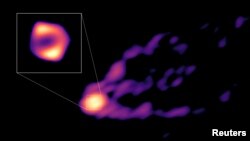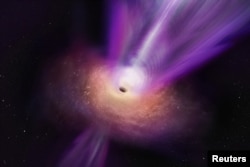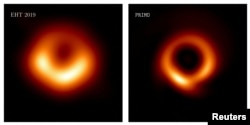Scientists last week released the first image showing the violent events surrounding a black hole. This image is one of just a few that have been taken of black holes. It included the point from which the black hole shoots out high-energy particles into space.
The new image was captured using 16 telescopes around the world that, in effect, created a planet-sized observational dish.
The supermassive black hole pictured is found at the center of a relatively nearby galaxy called Messier 87, or M87, about 54 million light-years from Earth. This black hole has a mass 6.5 billion times larger than our sun.
It was the subject of the first image of a black hole ever taken. That image was released in 2019. Another image of a black hole was taken last year.
But those images showed just the darkness of the black hole and surrounding bright material falling into it. They were taken from observations using several radio telescopes worldwide.
The latest image shows light at a longer wavelength, which expands what can be seen.
Black holes are hard to observe due to their nature. They are events found in space with a gravitational pull so strong that no matter or light can escape once caught too close.
Most galaxies are built around supermassive black holes. Some not only take in any surrounding material, but also send out bright jets of high-energy particles far into space – beyond the galaxy from which they are from.
The new image shows how the base of such a jet connects with material around the black hole. It shows the base of the jet of hot plasma, the light around the darkness of a black hole from hot plasma falling into it, and the central dark area.
Plasma is the fourth state of matter after solids, liquids, and gases. It is material so hot that some or all of its atoms are split into high-energy subatomic particles.
Scientist Ru-Sen Lu of the Chinese Academy of Sciences in Shanghai is the lead writer of the study, which was published in Nature. He said the image shows for the first time the connection between the material pulled inward near the central supermassive black hole and the point from which the jet starts.
Seeing the whole area near a supermassive black hole can be helpful to scientists.
Thomas Krichbaum of the Max Planck Institute for Radio Astronomy in Germany is a co-writer of the study. He said, “This helps to better understand the complicated physics around black holes, how jets are launched and accelerated and how matter inflow into the black hole and matter outflow are related.”
Kazunori Akiyama of the Massachusetts Institute of Technology’s Haystack Observation also co-wrote the study. He said this is what scientists “have been wanting to see for more than half a century.” He added that this is the beginning of an “exciting” new time.
Lu, Krichbaum, and Akiyama are members of the Event Horizon Telescope (EHT) project. The international working group formed in 2012 with the goal of directly observing a black hole’s surrounding environment.
I’m Gregory Stachel
Will Dunham reported this story for Reuters. Gregory Stachel adapted it for VOA Learning English.
__________________________________________________________________
Words in This Story
galaxy n. any one of the very large groups of stars that make up the universe
jet – n. a very strong stream of liquid or gas that comes out through a narrow opening
complicated – adj. having many parts or steps
accelerate – v. to move faster
exciting – adj. causing feelings of interest and enthusiasm
_________________________________________________________________
What do you think of this story?
We want to hear from you. We have a new comment system. Here is how it works:
- Write your comment in the box.
- Under the box, you can see four images for social media accounts. They are for Disqus, Facebook, Twitter and Google.
- Click on one image and a box appears. Enter the login for your social media account. Or you may create one on the Disqus system. It is the blue circle with “D” on it. It is free.
Each time you return to comment on the Learning English site, you can use your account and see your comments and replies to them. Our comment policy is here.











Forum